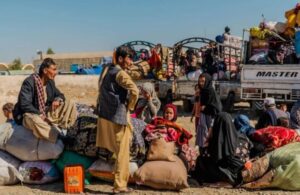KABUL (SW) – Afghanistan witnessed a string of deadly floods, torrential rains, earthquakes and drought that claimed more than 3000 lives in the past one year.
The climate changes, which increased the severity of natural events and extreme temperature fluctuations, brought an unprecedented cold to Afghanistan in the winter, as a result of which dozens of citizens died due to colds in different provinces.
In this report, the consequences of natural events in 16 provinces have been highlighted. These provinces include Paktika, Khost, Paktia, Badakhshan, Takhar, Baghlan, Laghman, Parwan, Kapisa, Panjshir, Daikundi, Bamyan, Uruzgan, Maidan Wardak, Ghazni and Ghor.
According to the data collected by Salam Watandar, as a result of these events in 13 provinces last year, 1,277 people died and 1,799 people were injured. Similar events last year in Takhar, Kapisa and Bamyan did not cause human casualties.
As a result of natural events this year, 1,932 residential houses have been completely destroyed and 9,778 houses have been partially destroyed in 16 provinces. Similarly, 16,966 other residential houses have been completely and partially destroyed without separation. As a result of natural events last year in these 16 provinces, 72,000 acres of farmland, 35,000 orchards, and 16,521 fruit and non-fruit trees were destroyed apart from these gardens. On the other hand, as a result of natural events in these provinces, more than 3,000 bridges and culverts and 1,925 kilometers of streets were destroyed.
Mohammad Abbas Akhundzada, acting minister of the disaster management affairs, told the media earlier this year that 1,152 people have died and 2,259 people have been injured due to natural events throughout Afghanistan this year. This figure is less than the casualties of 13 provinces that have been discussed in this report.
Akhundzada said that as a result of natural events last year, 80,000 cattle were lost all over Afghanistan and 9,808 residential houses and 147,747 acres of farmland have been destroyed.
Paktika
The deadliest natural event in Afghanistan last year was an earthquake that shook Paktika, Khost and Nangarhar. Mohammad Amin Huzaifa, the head of information and culture of Paktika, told Salam Watandar last year that more than 1,000 people died and 1,500 people were injured in this earthquake in the districts of Gyan, Barmal and Neke of this province.
Mutiullah Mansouri, head of natural disasters management in Paktika, said that in last year’s earthquake in this province, nearly 3,600 houses were completely and partially destroyed in Gyan and Barmal districts. Since more than one family lived in each of these houses, in total, more than seven thousand families have lost their homes.
According to Mansouri, last year 700 residential houses were destroyed due to other natural events such as floods and fires throughout Paktika, most of which occurred in Mutakhan, Urgon, Janikhel and Khairkot districts.
Khost
According to the data shared by the Khost natural disasters management department, 29 people died and 60 people were injured in the last summer’s earthquake in Sepiri district of this province.
Dost Mohammad Hilal, the head of the department, told Salam Watandar that in last year’s earthquake in this province, 4,700 houses were completely and partially destroyed. According to him, 3,850 houses and 1,800 acres of farmland were also destroyed due to the floods in Khost.
Paktia
As a result of rains and floods in Paktia, 22 people died and 17 people were injured. In these floods, 635 residential houses were completely destroyed and 1,264 houses were partially destroyed.
Nisar Ahmad Nejat, head of natural disasters in Paktia, says that as a result of floods in Paktia last solar year, more than 80% of the fields of this province and its products have been destroyed. According to him, international institutions have distributed aid to 80,000 families affected by natural events in various parts of Paktia, and the Department of Combating Natural Disasters in this province has distributed aid to more than 2,000 families.
On the other hand, the earthquake that occurred in Paktika and Khost last year destroyed many houses in Paktika and its residents are still living under tents.
Badakhshan
After Paktika, Badakhshan had the highest number of human casualties due to natural events last year. Avalanches, earthquakes and floods have been the most important natural events this year in Badakhshan.
Mohammad Kamgar, head of fighting against natural disasters in Badakhshan, said that 58 people died, 47 people were injured and 1,190 livestock were lost due to natural events last year in this province.
Ghazni
Last year, natural events in Ghazni also left deadly effects. According to the data of the directorate of combating natural disasters, in less than a year, 40 people have died due to natural events, especially floods in the center and the provinces of Ghazni. In these floods, two thousand and 500 residential houses were completely and partially destroyed.
Uruzgan
As a result of floods in the center and districts of Uruzgan last year, 26 people, including women and children, died, 17 people, including men and women, were injured, and 688 livestock were also lost.
As a result of rains and floods in Uruzgan, 48 residential houses were completely destroyed and 1,593 houses were partially destroyed last year. Likewise, 40,000 acres of farmland, 35,000 orchards and forests, 1,155 kilometers of streets, and 3,000 bridges and culverts have been destroyed by the floods.
Laghman
Natural events in Laghman also caused human casualties and financial losses. According to the data of the Laghman department of combating natural disasters, 26 people died, 88 people were injured and 700 residential houses were completely destroyed and 2000 houses were partially destroyed as a result of natural events in this province last year. Likewise, dams and six big bridges and hundreds of culverts have also been destroyed.
Baghlan
As a result of natural events, especially floods in Pol Khumri, Central Baghlan, Jalgah, Khanjan and Burqa districts of Baghlan last solar year, 17 people died, two people were injured, and 134 residential houses were completely destroyed and 262 houses were partially destroyed. Similarly, due to the flood in Baghlan, 878 acres of agricultural land was destroyed.
Parwan
According to the data shared by the directorate of natural disasters management in Parwan, 41 people died, 33 people were injured and 1,225 livestock were lost due to heavy rains and floods in this province last year. Abdul Aleem Ahmed, the head of the natural disasters management in Parwan, said that in these floods, 170 residential houses were completely destroyed and 366 residential houses were partially destroyed. Similarly, 21,973 acres of farmland, 116 km of streets and 531 embankments were also destroyed in these floods.
Ghor
According to the data of the department of natural disasters management in Ghor, a child died last year due to a landslide in Shahrak district of this province and a man was trapped under a rock in another district. As a result of natural events, one person died and two others were injured in the Bidan valley of Firouzkoh city, the center of Ghor. Similarly, last year due to rains, one house in Chaharsada district and one house in Margab district were completely destroyed.
According to the statistics, das a result of floods in Tiure district of Ghor, gardens were destroyed and in “Ahngaran” area in the center of this province, nearly 64 acres of farmland were flooded.
Maidan Wardak
According to the residents of Maidan Wardak and the department of natural disasters management of this province, last year, as a result of floods in the center and districts of Jalriz, Qir, Seyed Abad and Chek, nearly 100 houses collapsed and 11 people, including women and children, died.
Daikundi
According to the data of natural disasters management department, which was provided to Salam Watandar, at least four people died due to floods and avalanches in this province last year.
Azizullah Jihadmal, the head of natural disasters in Daikundi, said that as a result of natural events in this province last year, 99 residential houses were completely destroyed and 72 houses were partially destroyed, as a result of which, 1,172 people were displaced. According to Jihadmel, as a result of the floods in Daikundi, nearly 930 acres of cultivated fields were destroyed and 16,251 fruitful and unfruitful trees were destroyed or damaged. Similarly, in these events, 22 bridges and 218 kilometers of streets have been destroyed.
Bamyan
According to the data of the Bamyan department of natural disasters management, last year, 2,324 families in this province suffered losses due to natural events, of which 1,547 families received food and non-food aid and 91 families received cash aid.
Mohammad Aman Akhli, director of the department, told Salam Watandar that 26.4 million afghanis have been donated by the United Nations High Commissioner for Refugees (UNHCR) to rebuild the fields destroyed by the floods and clean the water channels.
Panjshir
Following floods and heavy snowfall in Panjshir last year, one person died, two people were injured and 1,250 livestock were lost. According to the data of the department of combating natural disasters of this province, in these events, 44 residential houses were completely destroyed and 71 houses were partially destroyed, 19 shops, six road bridges, 31 pedestrian bridges, 23 water supply networks, four schools, seven mosques and 41 kilometers of streets were destroyed.
Also, as a result of the floods in Panjshir last year, 974 acres of farmland were destroyed and more than 10,000 trees were destroyed.
Kapisa
According to the data shared by the Kapisa natural disaster management department with Salam Watandar, natural events in this province last year did not result in human casualties. This year, as a result of the flood, 34 residential houses were completely destroyed and 33 houses were partially destroyed, 100 acres of agricultural land, six bridges and culverts and three water channels were destroyed in Kapisa.
Takhar
According to the data of Takhar’s department of natural disasters management, 300 families were affected and 6,700 acres of farmland were destroyed due to the earthquake and floods in the last solar year in this province.
Ahmadsir Sajid, head of the department, told Salam Watandar that while some aid organizations have helped the families affected by natural events with food, tents and mobile toilets, but the families who suffered losses are not in good condition.
ENDS






